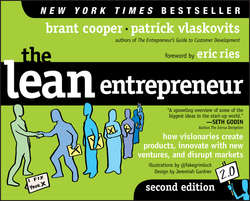Читать книгу The Lean Entrepreneur - Vlaskovits Patrick - Страница 7
На сайте Литреса книга снята с продажи.
Introduction
WHY READ (BE) THE LEAN ENTREPRENEUR?
ОглавлениеOur mission in writing The Lean Entrepreneur is threefold:
1. To describe why our economy is primed for a new wave of entrepreneurship using new methods of disruptive innovation.
2. To provide real-world examples of how entrepreneurs are creating new markets and disrupting others.
3. To show you how you can get started creating value.
The context of The Lean Entrepreneur is an iterative, customer-centric, data-informed business development approach in the face of market uncertainty. Although, to some degree, all businesses operate in conditions of market uncertainty, all such conditions are not created equal. Market uncertainty can be described by an innovation spectrum stretching from lesser market uncertainty when undertaking sustaining innovation to greater market uncertainty when pursuing truly disruptive innovation.
Uncertainty and innovation are a duality. Without the former, there is no opportunity for the latter. True disruptive innovation can only happen in environments in which the final product, and its value proposition, price, marketing, sales channels, and, most importantly, its customer are, at best, educated guesses but, more than likely, almost completely unknown.
The inverse is also true: If one is developing products for which the value proposition, price, marketing, sales channels, and market segments are known or very likely to be known, then iterative, customer-centric, data-driven approaches as espoused by The Lean Entrepreneur may be suboptimal.
Suffice it to say that when the value proposition is known and successfully delivered by a business to a known customer, the methods of execution used by its owners and employees are good enough, at least for now. Perhaps they could become more efficient or less wasteful, but to instruct successful businesses on how to be more efficient is not our ambition.
As you read The Lean Entrepreneur, we’ll make the case that innovating in uncertainty requires a highly iterative approach. We’ll also make the case that a disproportionate part of your business model is ultimately determined not by command-and-control diktats from the executive offices of your company or even your own personal desires but implicitly by the market segment you hope to provide value for. The sooner you grok that your customers have significant de facto control over the destiny of your business, the better it is for you, your customers, your employees, your colleagues, your shareholders, and other stakeholders in your business.
To belabor the point, it is your market segment, not you, that determines how you distribute your product, how much customers are willing to pay, what sort of messaging they respond to, and for what job they are in need of hiring a product. In other words, other than the fact that you can choose whether to serve a particular segment, it is up to the segment to decide whether you should be given a shot.
Since iterative, customer-centric, data-informed product development approaches to creating value predate this book, is this simply a gussied-up rehash of previous thinking?
Short answer: No.
We hear time and time again that the greatest contribution made by Eric Ries and the Lean Startup is the lexicon. It provides a language for anyone practicing entrepreneurship to talk about how to do meaningful innovation. The point has never been about who came up with what, but, rather, how we can learn from past successes to make future endeavors more predictable.
We feel that we are now witnessing a phase marked by radical disequilibrium and fundamental changes in innovation and entrepreneurship enabled by a juggernaut of technological and cultural trends.
The best way to navigate the near future is to hyperfocus on creating value for customers and moving at the speed of the Internet. We’ll show you how.
